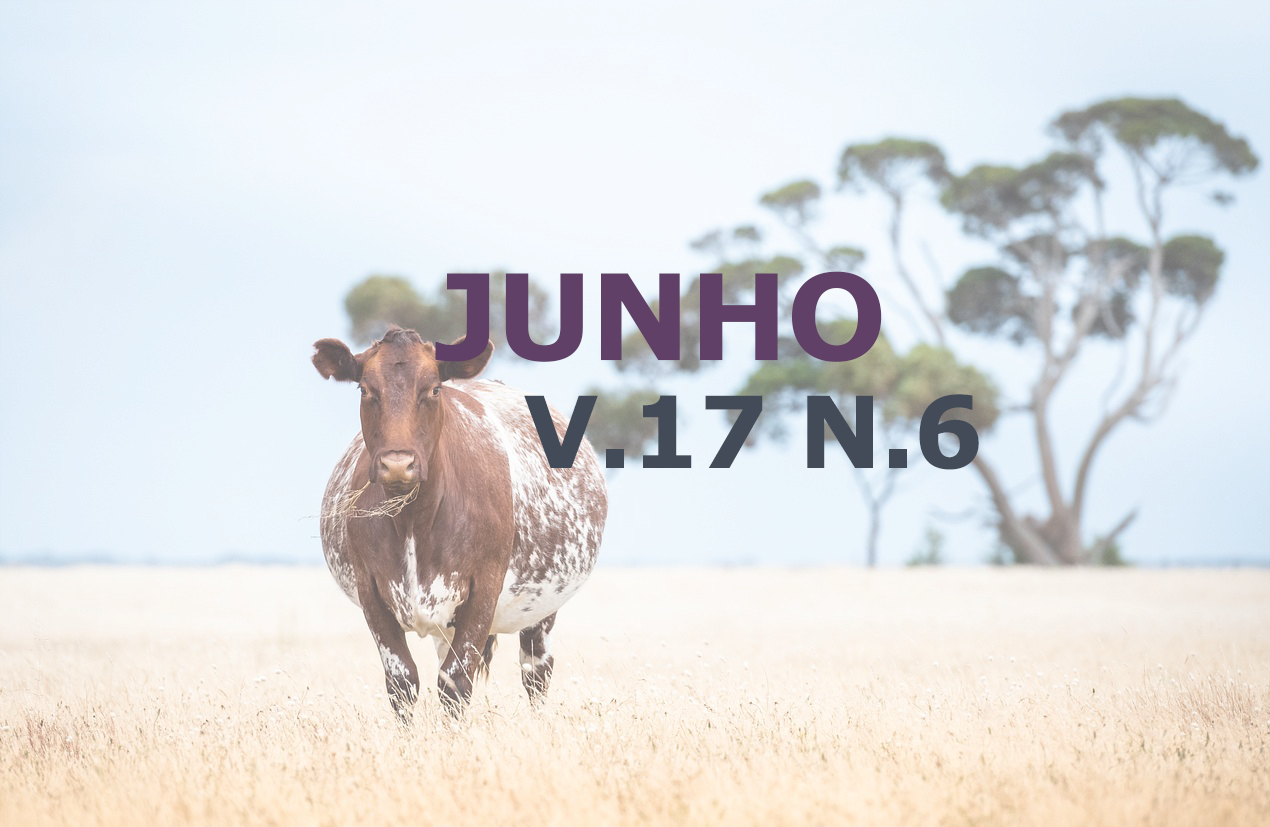Eficiência de diferentes tipos de inoculantes na cultura da soja
DOI:
https://doi.org/10.31533/pubvet.v17n6e1400Palavras-chave:
leguminosa, nitrogênio, produçãoResumo
A inoculação de Bradyrhizobium específico para a cultura da soja é uma prática indispensável de cultivo dessa leguminosa, neste estudo, optou-se pela inoculação tradicional, via semente. O experimento foi desenvolvido em um solo classificado como latossolo vermelho com textura média em um utilizado delineamento inteiramente casualizado (DIC), com 4 tratamentos e 7 repetições, cada unidade experimental foi constituída de 1 m2, os tratamentos analisados foram: (T1) inoculante líquido, (T2) inoculante turfoso (T3) inoculante líquido + turfoso, (T4) sem inoculante. O objetivo proposto neste estudo foi verificar a necessidade de utilizar inoculantes no plantio da soja em áreas com cultivo da cultura a mais de seis anos. De acordo com o teste F verificou-se diferença significativa entres os tratamentos, sendo que o tratamento (T3) destacou-se entre os demais para comprimento de raiz, quantidade de nódulos e concentração de nitrogênio na folha. O tratamento (T2) embora tenha sido inferior ao (T3) apresentou melhores resultados que os tratamentos (T1) e (T4). Nas condições experimentais utilizando a cultivar Brasmax Bônus 8579IPRO houve uma diferença significativa na utilização dos produtos, com destaque para a inoculação liquida + turfoso (T3), apresentando uma maior concentração de nitrogênio na folha da planta, obtendo ainda um maior número de nódulos e comprimento de raiz. Como o valor da estatística F para a variável comprimentos médios de raiz, número médio de nódulos e teor médio de nitrogênio foliar supera o valor crítico no nível de 1% de probabilidade (4,72), elas são significativas nesse nível (P < 0,01). Como o valor de F calculado foi maior que o valor de F tabelado para as três variáveis analisadas rejeitamos a hipóteses nula (H0), e concluímos que as variáveis analisadas possuem efeitos diferentes. Diante disso, podemos concluir que o mais recomendado para inoculação seria utilizar os dois produtos.
Referências
Battisti, A. M., & Simonetti, A. P. M. (2014). Inoculação e Co inoculação com Bradyrhizobium japonicum e Azospirillum brasilense na cultura da soja. Revista Cultivando o Saber, 8(3), 294–301. https://doi.org/10.14393/ufu.te.2019.1247.
Braccini, A. L., Mariucci, G. E. G., Suzukawa, A. K., Lima, L. H. S., & Piccinin, G. G. (2016). Co-inoculação e modos de aplicação de Bradyrhizobium japonicum e Azospirillum brasilense e adubação nitrogenada na nodulação das plantas e rendimento da cultura da soja. Scientia Agraria Paranaensis, 15(1), 27–35. https://doi.org/10.18188/1983-1471/sap.v15n1p27-35.
Bulegon, L. G., Rampim, L., Klein, J., Kestring, D., Guimarães, V. F., Battistus, A. G., & Inagaki, A. M. (2016). Componentes de produção e produtividade da cultura da soja submetida à inoculação de Bradyrhizobium e Azospirillum. Terra Latinoamericana, 34(2), 169–176. https://doi.org/10.22533/at.ed.58222180413.
Chibeba, A. M., Guimarães, M. F., Brito, O. R., Araújo, R. S., Nogueira, M. A., & Hungria, M. (2015). Tecnologia e mercado global: Perspectivas para a soja. Congresso Brasileiro de Soja.
Fachinelli, R., & Ceccon, G. (2020). Coinoculação com Bradyrhizobium e Azospirillum na soja em sucessão ao milhosafrinha em solo arenoso e argiloso. In Embrapa Acre-Circular Técnica (pp. 1–10). Acta Iguazu, Cascavel, v. 9, n. 2, p. 99-108, 2020.
Fipke, G. M. (2015). Co-inoculação e pré-inoculação de sementes em soja. Universidade Federal de Santa Maria.
Hungria, M., Nogueira, M. A., & Araújo, R. S. (2013). Tecnologia de coinoculação da soja com Bradyrhizobium e Azospirillum: incrementos no rendimento com sustentabilidade e baixo custo. XXXIII Reunião de Pesquisa de Soja Da Região Central do Brasil. https://doi.org/10.46311/ed.un.20221018145.
Naoe, A. M. L., Peluzio, J. M., Campos, L. J. M., Naoe, L. K., & Silva, R. A. (2019). Coinoculação com Azospirillum brasilense em cultivares de soja submetidas a deficit hídrico. Revista Brasileira de Engenharia Agrícola e Ambiental, 24(2), 89–94. https://doi.org/10.1590/1807-1929/agriambi.v24n2p89-94.
Pastore, A. (2016). Manejo de inoculação com Bradyrhizobium em soja associado ao tratamento fitossanitário das sementes. Universidade Federal do Parná.
Pias, T. H. (2014). Diferentes tipos de tratamentos de sementes para a cultura da soja (glycine max L.). Universidade Regional do Noroeste do Estado do Rio Grande do Sul.
R-Core-Team. (2016). R: A language and environment for statistical computing. R. Foundation for Satatical Computing.
Sordi, A., Scheneider, F., Panizzon, L. C., Lajús, C. R., Cericato, A., & Klein, C. (2017). Eficiência agronômica da cultura da soja (Glycine max (L.) Merril) submetida a coinoculação. Scientia Agraria, 18(4), 72–79. https://doi.org/10.5380/rsa.v18i4.52047.
Zuffo, A. M., Adriano, T. B., Pedro, M. R., Mariane, C. B., Everton, V. Z., Igor, O. S., Augusto, B. M. R., & Guilherme, L. D. V. (2016). Morphoagronomic and productive traits of RR soybean due to inoculation via Azospirillum brasilense groove. African Journal of Microbiology Research, 10(13), 438–444. https://doi.org/10.5897/ajmr2015.7682
Zuffo, A. M., Rezende, P. M., Bruzi, A. T., Oliveira, N. T., Soares, I. O., Neto, G. F. G., Cardillo, B. E. S., & Silva, L. O. (2015). Co-inoculation of Bradyrhizobium japonicum and Azospirillum brasilense in the soybean crop. Revista de Ciências Agrárias, 38(1), 87–93. https://doi.org/10.5433/1679-0359.2020v41n6Supl2p2937
Downloads
Publicado
Edição
Seção
Licença
Copyright (c) 2023 Aurélio Ferreira Melo, Thais Miranda Silva Freitas, Roberto Barbuio, Juracy Mendes Moreira, Antônio Florentino de Lima Junior

Este trabalho está licenciado sob uma licença Creative Commons Attribution 4.0 International License.
Você tem o direito de:
Compartilhar — copiar e redistribuir o material em qualquer suporte ou formato
Adaptar — remixar, transformar, e criar a partir do material para qualquer fim, mesmo que comercial.
O licenciante não pode revogar estes direitos desde que você respeite os termos da licença. De acordo com os termos seguintes:
Atribuição
— Você deve dar o crédito apropriado, prover um link para a licença e indicar se mudanças foram feitas. Você deve fazê-lo em qualquer circunstância razoável, mas de nenhuma maneira que sugira que o licenciante apoia você ou o seu uso. Sem restrições adicionais
— Você não pode aplicar termos jurídicos ou medidas de caráter tecnológico que restrinjam legalmente outros de fazerem algo que a licença permita.





